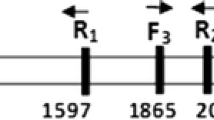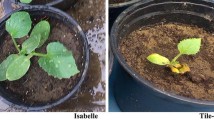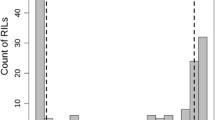Abstract
Fusarium wilt caused by Fusarium oxysporum f.sp. melonis is one of the most devastating diseases in melon production worldwide. The most effective control measure available is the use of resistant varieties. Identifying molecular markers linked to resistance genes can serve as a valuable tool for the selection of resistant genotypes. Bulked segregant analysis was used to identify markers linked to the Fom-2 genes, which confers resistance to races 0 and 1 of the fungal pathogen. Pooled DNA from homozygous resistant or homozygous susceptible progeny of F2 cross between MR-1 and AY was screened using 240 PstI/MseI and 200 EcoRI/MseI primer combinations to identify AFLP markers linked to Fom-2. Fifteen markers potentially linked to Fom-2 were identified, all with EcoRI/MseI primer pairs. These were mapped relative to Fom-2 in a backcross (BC) population of 60 progeny derived from MR-1 × AY with AY as recurrent parent. Two AFLP markers (ACT/CAT1 and AAC/CAT1) flanked the gene at 1.7 and 3.3 cM, respectively. Moreover, AFLP marker AGG/CCC and the previously identified RAPD marker 596-1 cosegregated with Fom-2. These two dominant markers were converted to co-dominant markers by designing specific PCR primers that produced product length polymorphisms between the parents. A survey of 45 melon genotypes from diverse geographic origins with the co-dominant markers demonstrated a high correlation between fragment size and the resistance phenotype. These markers may therefore be useful in marker-assisted breeding programs.
Similar content being viewed by others
References
Banihashemi Z, DeZeeuw DJ: The behavior of Fusarium oxysporum f.sp. melonis in the presence and absence of host plants. Phytopathology 65: 1212–1217 (1975).
Barzen E, Stahl R, Fuchs E, Borchardt DC, Salamini F: Development of coupling repulsion-phase SCAR markers diagnostic for the sugar beet Rr1 allele conferring resistance to rhizomania. Mol Breed 3: 231–238 (1997).
Baudracco-Arnas S: A simple and inexpensive method for DNA extraction from Cucumis melo L. Cucurbit Genet Coop Rep 18: 50–51 (1995).
Baudracco-Arnas S, Pitrat M: A genetic map of melon (Cucumis melo L.) with RFLP, RAPD, isozyme, disease resistance and morphological markers. Theor Appl Genet 93: 57–64 (1996).
Blancard D, Lecoq H, Pitrat M: A Colour Atlas of Cucurbit Diseases: Observation, Identification and Control. JohnWiley, New York (1994).
Giovannoni JJ, Wing RA, Ganal MW, Tanksley SD: Isolation of molecular markers from specific chromosomal intervals using DNA pools from existing mapping populations. Nucl Acids Res 19: 6553–6558 (1991).
Gordon TR, Jacobson DJ, May DM, Tyler KB, Zink FW: Fruit yield, disease incidence and root colonization of hybrid muskmelons resistant to fusarium wilt. Plant Dis 74: 778–781 (1990).
Gwynne BJ, Gordon TR, Davis RM: A new race of Fusarium oxysporum f.sp. melonis causing fusarium wilt of muskmelon in the central valley of California. Plant Dis 81: 1095 (1997).
Lichtenstein CP, Draper J: Genetic engineering of plants. In: Glover DM (Ed.) DNA Cloning: A Practical Approach, Vol II, pp. 67–119. IRL Press, London (1985).
McCreight JD, Nerson H, Grumet R: Melon Cucumis melo L. In: Kalloo G, Berch BO (Eds.) Genetic Improvement of Vegetable Crops, pp. 267–294. Pergamon Press, Oxford (1993).
Martyn RD, Gordon TR: Fusarium wilt of melon. In: Zitter TA, Hopkins DL, Thomas CE (Eds.) Compendium of Cucurbit Diseases. pp. 14–15. APS Press, MN (1996).
Melotto M, Afanador L, Kelly JD: Development of a SCAR marker linked to the I gene in common bean. Genome 39: 1216–1219 (1996).
Michelmore RW, Paran I, Kesseli RV: Identification of markers linked to disease-resistance genes by bulked segregant analysis: a rapid method to detect markers in specific genomic regions by using segregating populations. Proc Natl Acad Sci USA 88: 9828–9832 (1991).
Mohler V, Jahoor A: Allele-specific amplification of polymorphic sites for the detection of powdery mildew resistance loci in cereals. Theor Appl Genet 93: 1078–1082 (1996).
Paran I, Michelmore RW: Development of reliable PCR-based markers linked to downy mildew resistance genes in lettuce. Theor Appl Genet 85: 985–993 (1993).
Paterson AH: DNA marker-assisted crop improvement. In: Paterson AH (Ed.) Genome Mapping in Plants, pp. 71–83. Academic Press, New York (1996).
Reiter RS, Williams JGK, Feldman KA, Rafalski A, Tingey SV, Scolnik PA: Global and local genome mapping in Arabidopsis thaliana by using recombinant inbred lines and random amplified polymorphic DNAs. Proc Natl Acad Sci USA 89: 1477–1481 (1992).
Risser G: Controversy on resistance to Fusarium wilt in 'Perlita' (Cucumis melo L.). Cucurbit Genet Coop Rep 10: 60–61 (1987).
Sherf AF, Macnab AA: Fusarium wilt of muskmelon. In: Vegetable Diseases and Their Control, 2nd ed. pp. 334–337. John Wiley, New York (1986).
Smith S, Beavis W: Molecular marker assisted breeding in a company environment. In: Sobral BWS (Ed.) The Impact of Plant Molecular Genetics, pp. 259–272. Birkhauser, Boston (1996).
Thomas CM, Vos P, Zabeau M, Jones DA, Norcott KA, Chadwick BP, Jones JDG: Identification of amplified restriction fragment polymorphism (AFLP) markers tightly linked to the tomato Cf-9 gene for resistance to Cladosporium fulvum. Plant J 8: 785–794 (1995).
Thomas CE, McCreight JD, Jourdain EL: Inheritance of resistance to Alternaria cacumerina in Cucumis melo line MR-1. Plant Dis 74: 868–870 (1990).
Thomas CE, McCreight JD, Zink FW, Jourdain EL: Inheritance of disease resistance in muskmelon line MR-1. Proceedings Fifth EUCARPIA Cucurbitaceae Symposium, 27-31 July 1992, Warsaw, Poland, pp. 143-147 (1992).
Wang Y-H, Thomas CE, Dean RA: A genetic map of melon (Cucumis melo L.) based on amplified fragment length polymorphism (AFLP) markers. Theor Appl Genet 95: 791–798 (1997).
Wechter WP, Thomas CE, Dean RA: Development of sequence specific primers which amplify a 1.5 kb DNA marker for race 1 fusarium wilt resistance in Cucumis melo. HortScience 33: 291–292 (1998).
Wechter WP, Whitehead MP, Thomas CE, Dean RA: Identification of a randomly amplified polymorphic DNA marker linked to the Fom-2 fusarium wilt resistance gene in muskmelon MR-1. Phytopathology 85: 1245–1249 (1995).
Zheng XY, Wolff DW, Baudracco-Arnas S, Pitrat M: Development and utility of cleaved amplified polymorphic sequences (CAPS) and restriction fragment length polymorphisms (RFLPs) linked to the Fom-2 fusarium wilt resistance gene in melon (Cucumis melo L.). Theor Appl Genet 99: 453–463 (1999).
Zink FW: Origin of Fusarium wilt resistance in Texas AES muskmelon cultivars. Plant Dis 75: 24–26 (1991).
Zink FW, Gubler WD: Inheritance of resistance in muskmelon to Fusarium wilt. J Am Soc Hort Sci 110: 600–604 (1985).
Zink FW, Thomas CE: Genetics of resistance to Fusarium oxysporum f.sp. melonis races 0, 1, and 2 in muskmelon line MR-1. Phytopathology 80: 1230–1232 (1990).
Zuniga TL, Zitter TA, Gordon TR, Schroeder DT, Okamoto D: Characterization of pathogenic races of Fusarium oxysporum f.sp. melonis causing fusarium wilt of melon in New York. Plant Dis 81: 592–596 (1997).
Author information
Authors and Affiliations
Rights and permissions
About this article
Cite this article
Wang, YH., Thomas, C.E. & Dean, R.A. Genetic mapping of a fusarium wilt resistance gene (Fom-2) in melon (Cucumis melo L.). Molecular Breeding 6, 379–389 (2000). https://doi.org/10.1023/A:1009671925793
Issue Date:
DOI: https://doi.org/10.1023/A:1009671925793




